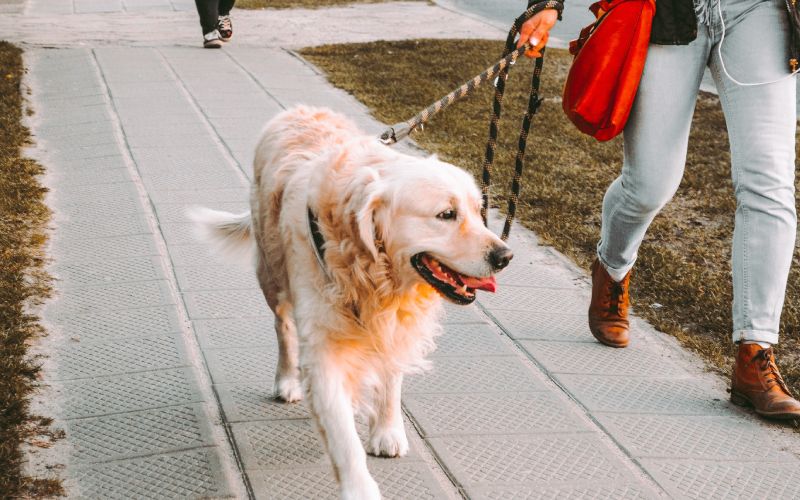At dallastxdogtrainers.com, we are often called about dogs that are having leash reactivity.
Does your furry pal overreact when on a leash? He growls and barks at anyone who seems unfamiliar and even tries attacking other animals. Well, I must admit this can be a stressful situation.
But what you must understand is that dogs don’t behave like this normally. There are certain reasons why your canine is overreacting, and it’s your responsibility to uncover that reason and manage the situation effectively.
In today’s post, we will help you with exactly that. From what is leash reactivity to how you can manage it, here is everything you need to know!
What is Leash Reactivity in Dogs?
Leash reactivity is a type of behavior that occurs when a leashed dog gives a weird response to any stimulus. For example, if your off-leash dog acts calm towards approaching strangers, he may growl and bark aggressively when leashed. Your dog may also:
- Bite the leash or tug at it
- Try to run away
- Focus intensely on others
- Whine or cry when someone approaches
- Freeze and refuse to walk
- Hide behind you
- Lunge towards people and other animals
This difference in behavior means your dog is leash-reactive. However, please note that unfamiliar humans and dogs aren’t the only triggers.
A leash-reactive dog can have as specific triggers as a bearded man. These triggers can also change with time, so you might want to keep track of what things bother your canine.
Causes of Leash Reactivity
Leash reactivity in dogs can have various underlying reasons. Here’s an overview of some commonly found ones:
Feeling Threatened
When a dog meets someone new, he will prefer to keep his head low and investigate. He will circle the new dog and sniff at it to decide whether he likes it or not. If he likes it, he will make eye contact and get comfortable.
This is how dogs naturally greet each other. However, being on a leash makes things difficult and your dog is forced to meet the new dog face-to-face. This results in direct eye contact, which is perceived as a threat in the dog world.
So, even if your dog wants to explore the new dog and be friendly, the sudden eye contact makes him feel threatened and stimulates him to take action. But since he can’t move around freely, the situation worsens – hence causing leash reactivity.
Please note this is particularly common in territorial dog breeds or those with high energy levels and prey drive.
Lack of Socialization
Dogs who grew up in confinement or without the company of other canines can develop anxiety and fearfulness. They become easily overwhelmed when exposed to an unfamiliar situation on a leash.
They will try to run or hide from anything strange. In other cases, the heightened sensitivity and overstimulation will cause them to act defensively. They might go as far as harming the approaching person or dog.
Negative Past Experiences
If a dog has faced traumatic or aggressive encounters while on a leash, he can develop a negative association between the leash and him. It doesn’t matter whether you are in the house or outside. The dog will not let you put on a leash.
He will give a defensive response as a means of self-preservation. And even if you manage to put on the leash, the dog will immediately start tugging at it or become stiff (refusing to move). In severe cases, the dog may start barking and growling at you.
How to Manage Leash Reactivity?
When a dog becomes leash reactive, your natural response would be saying no and tugging at the leash to stop the dog. You might even scream or yell. However, these are not the correct responses and will only make your dog more anxious.
You need to stay calm and find ways to redirect the dog’s focus. Call out his name or give him a treat. If the situation gets worse, take the dog away from the stimulus (by force – if necessary) and understand that your dog needs leash reactivity training.
This weeks-long training will change your dog’s response to the stimulus. Now, there are different ways to do that, and you can start practicing them with your dog at home.
Command Words
Train your dog to listen to his name or certain command words (such as LOOK) no matter what happens. You can do this by using the command word in a low-distraction place and rewarding your dog when he listens.
Once your dog gets better, repeat the process at a slightly more distracting area. Keep doing this until your dog has mastered the skill.
Counterconditioning
In this technique, you will train your canine to associate the stimulus with positive things like yummy treats or praise. Whenever he comes across the stimulus, give him a treat to encourage the thought: hey, this thing is good.
Eventually, your dog will be conditioned to the thought and will stop acting defensively.
Calming Supplements
These over-the-counter supplements can be used along the above-mentioned techniques. But don’t use them routinely, and always consult a vet before using one.
Please note leash reactivity training is a patient process and may not always be successful. You need to study the dog’s behavior and use one or more techniques to get rid of leash reactivity. In extreme cases, your dog may need basket muzzles and other supplies.
We’re Here to Help!
Leash reactivity is a behavioral disorder and not a lifelong disease. Some dogs may indeed need months to get normal. But with patience and positive training, your dog can once again enjoy walking around on a leash.
Need help with leash reactivity training? OffLeash K9 training says to tell your dog we said Hello! 👋
Our team of professionals has successfully corrected leash reactivity in hundreds of dogs across the DFW Metroplex.


